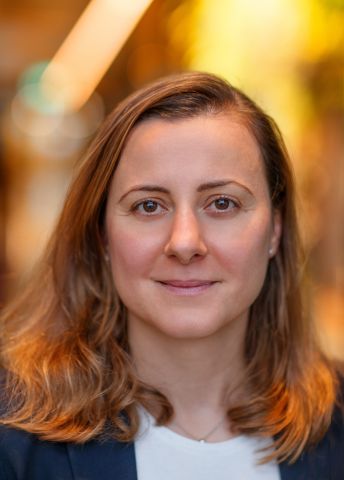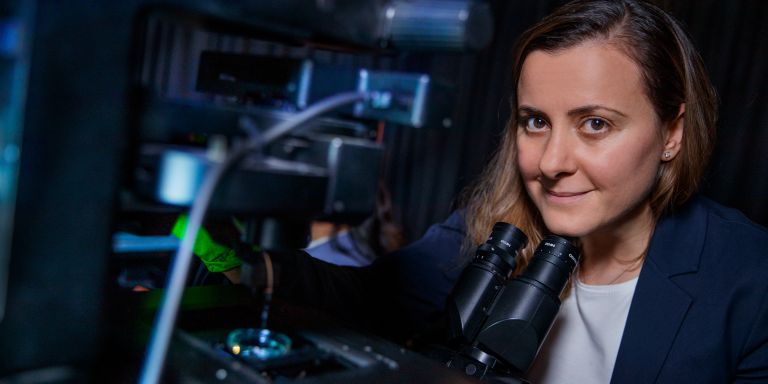
Elif Eroglu
PhD in Molecular Biology
Wallenberg Academy Fellow 2023
Institution:
Karolinska Institutet
Research field:
Mapping the salamander’s ability to regenerate its heart cells


Wallenberg Academy Fellow 2023
Institution:
Karolinska Institutet
Research field:
Mapping the salamander’s ability to regenerate its heart cells
During a heart attack, we can lose as many as a billion heart cells. Instead of healthy cells, a scar forms on the heart, making the tissue less flexible. A heart with large scars struggles to beat regularly, which can lead to heart failure.
The salamander’s heart also forms a scar after an attack. However, the scar tissue soon transforms into healthy cells, allowing the heart to beat as strongly as before. The ability of salamanders to regenerate tissues and even entire limbs has been known for a long time. Few, however, have delved deeply into their genes and proteins to truly understand what governs this ability.
“Over the past 20 years, our understanding of heart regeneration has grown exponentially, but most research has focused on zebra fish, which differ significantly from humans. Salamanders are more challenging to work with, but we believe they can provide new knowledge that can be applied to humans,” says Eroglu.
Her abiding interest in the heart and its cells stems from a personal experience in her youth. Her grandfather suffered a fatal heart attack when he was only in his fifties.
“The helplessness I felt when I suddenly lost a loved one has remained with me. As a doctoral student, I worked on brain tumors, but my goal has always been to create new hearts,” says Eroglu.
In fact, multiple research groups are working with salamanders at Karolinska Institutet. Some are studying cells in the spinal cord and brain; Eroglu is focusing on the heart.
“Together, we can truly push the boundaries of what we know. We are now able to track heart cell renewal using advanced imaging techniques, which is fascinating to see,” she says.
Both human and salamander heart walls are composed of three distinct tissue layers with different properties and functions. Currently, Eroglu’s research team’s main interest is in the outermost layer – the epicardium. That layer forms a barrier that protects the heart from its surroundings.
“When the salamander’s heart is damaged, cells in the outer layer are activated and gain the ability to regenerate dead cells. At the same time, a type of progenitor cell migrates to the injury from this outer layer."
The stem cells that reach the damaged area form a cluster that can help regenerate damaged tissue. The research group is now trying to create similar clusters using human heart cells. These experiments are being conducted in the lab using organoids in the form of miniaturized hearts. But understanding what governs cluster formation is not simple.
“When we compare the genes expressed in salamander and human heart cells, they seem to be the same. We therefore need to consider factors such as the impact of the immune system to really understand what is happening.”
The salamander’s DNA is more than six times larger than our own. Some researchers believe this explains their regenerative ability. Others argue that humans may have once had this ability but that evolution prioritized the development of a strong immune system.
“For me, it is important to strive for diversity in my research team. People from different parts of the world tend to have different perspectives and approaches to the same questions. This benefits our research."
“We don't have answers to these questions, and they are also very difficult to investigate. One discovery we’ve made is that salamander cells attach to each other and interact differently than human cells.”
The research team has identified a protein that may lead the way. It is present in both species but can cause cancer in humans.
“Another difference between us is that the scar tissue in salamanders has a honeycomb-like structure. This is very stable and may provide a kind of scaffold that makes it easier to regenerate new tissues.”
One of the goals Eroglu hopes to achieve with the Wallenberg Academy Fellow grant is a kind of map that describes how scar tissue can contribute to new healthy heart cells.
The research is highly interdisciplinary, and her team includes a broad range of specialists – from computational biologists to molecular biologists and engineers.
“When I worked as a postdoc, I realized that researchers often follow in each other's footsteps. My goal is to always have an interdisciplinary approach. The heart is essentially a kind of pump – and who understands that technology better than engineers?”
As a young researcher, it can be easy to become absorbed in work. However, leaning against a wall in Eroglu’s office is a pair of cross-country skis. Although she grew up in the snow-free metropolis of Istanbul, she has found a new hobby in skiing. Her family frequently visits the mountain resort of Funäsdalen.
“We go there quite often, and I’ve discovered how relaxing skiing is. Being out in nature is a good way to take a break from research.”
Text Magnus Trogen Pahlén
Translation Maxwell Arding
Photo Magnus Bergström